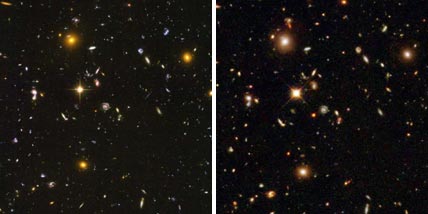
A small portion of the Hubble Ultra Deep Field (HUDF), as seen in visible light by Hubble's Advanced Camera for Surveys, or ACS (left), and by the Near Infrared Camera and Multi-Object Spectrometer, or NICMOS (right). Though the ACS image sees fainter objects and shows finer details, the infrared-sensitive NICMOS frame may contain the oldest starlight gathered in the course of the HUDF survey.
Courtesy NASA, ESA, S. Beckwith, R. Thompson, and the HUDF Team.
Using the largest telescopes in space and on Earth, various groups of astronomers are shedding new light on the dawn of the cosmos. The verdict so far: the "Dark Age" that followed the Big Bang probably lasted longer than thought and ended only gradually, with the first stars and galaxies lighting up the cosmos in fits and starts rather than in one nearly simultaneous, grand opening of light. Moreover, these very first stars may not have been as massive and brilliant as recently believed.
"To see the first stars and first galaxies has been the Holy Grail of cosmology for a long time," comments Space Telescope Science Institute director Steven Beckwith. "Right now, we’re beginning to see this."
The Hubble Space Telescope played an important role in the new results, which were presented Wednesday at the American Astronomical Society meeting in Denver. A couple dozen extremely faint, extremely red objects that were detected in the Hubble Ultra Deep Field — a 11.3-day-long exposure of a small patch of sky in Fornax by Hubble’s Advanced Camera for Surveys — have been studied in detail by two teams led by Sangeeta Malhotra (STScI) and Richard S. Ellis (Caltech). Many of the objects turn out to be small, misshapen galaxies at redshifts around 6, corresponding to an epoch when the universe was about 1 billion years old.
Surprisingly, if you correct for their large redshifts, the superdistant galaxies have pretty normal colors, says Malhotra, who studied them with Hubble’s grism spectrograph. "We don’t need particularly massive or blue stars to make up these galaxies," she says.
Ellis agrees. His team used a spectrograph on one of the 10-meter Keck telescopes in Hawaii to determine the ionizing ultraviolet output of this early population of galaxies. He concludes that they were too few and weak to fully explain the reionization of the dark, neutral hydrogen gas filling the universe after the Big Bang cooled. Astronomers are convinced that the cosmic "reionization era" must have taken place sometime during the first billion years after the Big Bang, as the first galaxies and quasars lit up.
Even a dim galaxy at a redshift of 7, amplified by the gravitational lensing effect of an intervening cluster, turns out to have a quite normal stellar population, says Ellis. His team reported its discovery of the lensed galaxy, one of the most remote ever observed, in February. Since then it has been observed with NASA’s infrared Spitzer Space Telescope. The Spitzer data indicate that the galaxy is fairly evolved, with an age of some 150 million years. According to Ellis, that would indicate that it formed when the universe was a mere 600 million years old — a time once assumed to be in the Dark Age.
Earlier during the AAS meeting, Aparna Venkatesan (University of Colorado) and Jason Tumlinson (University of Chicago) argued that the very first generation of stars in the universe — the "Population III" stars that presumably ended the Dark Age — may indeed have been less extreme than the 500-solar-mass behemoths of pure hydrogen and helium that astronomers have assumed they were. To explain both the ionization that took place in the early universe and the elemental composition of the second generation of stars, you need first-generation stars between 20 and 100 solar masses, they calculated.
Malhotra, together with her STScI colleague James E. Rhoads, presented evidence that the reionization of the universe was a "relatively protracted and complex process," as Rhoads put it. Data on distant quasars from the Sloan Digital Sky Survey, and on the cosmic microwave background from NASA's WMAP satellite, indicate that the bulk of the intergalactic neutral hydrogen was already ionized by the time the universe was just a few hundred million years old. But according to Rhoads and Malhotra, the process may have taken the better part of a billion years to complete.
As part of their Large Area Lyman Alpha (LALA) survey, the astronomers studied a galaxy at a redshift of 6.535 (known as LALA J142442.24 +353400.2) with the Gemini North telescope in Hawaii. From their measurements they conclude that up to 10 percent of the hydrogen gas in the universe might still have been neutral as late as 850 million years after the Big Bang. Apparently, reionization happened at different rates in different places.
According to Ellis, the objects studied so far may not really be
representative of the first population of galaxies. "There must be plenty more exciting stuff out there," he says.
Beckwith agrees. "Right now, we’re probably seeing just the tip of the iceberg. I doubt very much that we will fully understand this problem without the James Webb Space Telescope," Hubble's planned infrared successor.
 0
0
Comments
You must be logged in to post a comment.